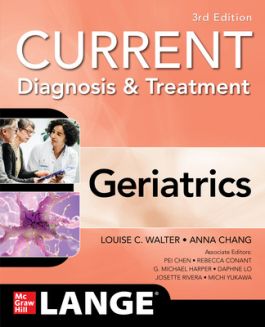Current Diagnosis and Treatment: Geriatrics, 3/e
3rd Edition
1260457087
·
9781260457087
© 2021 | Published: September 30, 2020
The definitive guide to safe, effective care of older adults—updated with important new content and streamlined for quick accessA Doody's Core Title for 2024 & 2023!Covers the complete range of topics in geriatric care, including theory and fun…
Read More
Purchase Options
Request Review Copy
Table of Contents
Section1. Principles of Geriatric Assessment and Care
- Introduction to the Care of Older Persons: Knowledge, Skills & System Change
- Guiding Principles
- Overview of Geriatric Assessment (6)
- Geriatric Assessment in Primary Care
- Teams
- Patient Goals
- Prognosis
- Functional Assessment
- Falls & Gait Impairment
- Vision Impairment
- Hearing Impairment
- Dementia
- Incontinence
- Depression
- Nutrition
- Medication Use
- Caregiver Support
- Financial, Environmental and Social Resources
- Abuse
- Preventive Services
- The Interprofessional Team (5)
- Key Definitions & Context
- Innovations in Geriatric Interprofessional Teams
- Evidence for Interprofessional Teams
- Barriers to Teamwork
- Resources and Tools for Teamwork
- Goals of Care and Consideration of Prognosis (3)
- Guide to Goals of Care Discussions
- Importance of Surrogate Decision Makers
- Prognostication
- Prognosis Related to Specific Diseases
- Communicating Prognosis to Patient or Surrogate
- Functional Assessment & Functional Decline (2)
- Epidemiology of Func
The definitive guide to safe, effective care of older adults—updated with important new content and streamlined for quick access
A Doody's Core Title for 2024 & 2023!
- Covers the complete range of topics in geriatric care, including theory and fundamentals, assessment, conditions, diseases, symptoms, policies, and societal issues that affect older patients
- Provides a framework for using the functional and cognitive status, prognosis, and social context of patients to guide diagnosis and treatment of medical conditions
- Delivers essential information on important topics such as delirium, cognitive impairment, dementia, falls and mobility disorders, Parkinson disease and other movement disorders, sleep disorders, and arthritis
- Includes guidance on care in all settings – clinic, home, hospital, and long-term care, as well as pre- and post-operative settings
- New content on technology to enhance geriatric care, caregiving support, the unique needs of older immigrants, Medicare and Medicaid, legal issues and conservatorship, aid in dying, assisted living care, short-stay rehabilitation, prostate cancer, marijuana use, syncope, and driving safety

